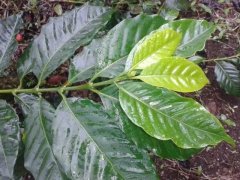The difference between Arabica beans and Robusta beans 11 differences between Arabica and Robusta
What's the difference between two heavyweights in the coffee world? Let's do a little Arabica versus Robusta coffee comparison. Arabica coffee originated in the southwestern highlands of Ethiopia and is the most popular coffee variety in the world-accounting for 60% or more of the world's coffee production.
Next in popularity to Arabica coffee is Robusta coffee, which is made from coffee beans of the coffee bean plant.
Arabica coffee has less caffeine than Robusta coffee. Arabica coffee has 1.5% caffeine, while Robusta coffee has 2.7% caffeine. For people worried about the negative effects of too much caffeine, this may be a consideration. In their case, Arabica coffee would be the better option. Caffeine also has a bitter taste-which makes Arabica coffee less bitter than Robusta coffee.
Arabica coffee contains more sugar than Robusta coffee. Arabica coffee contains almost twice as much sugar as Robusta coffee. Most people prefer sweet to bitter, which may be responsible for the difference in popularity.
Arabica coffee contains more lipids than Robusta coffee. Arabica coffee contains about 60% more lipids (fats, oils, waxes, certain vitamins, hormones...).
Arabica coffee is more acidic than Robusta coffee. It's like the acidity that makes wine taste good. It adds fruit, chocolate and nutty flavors to Arabica coffee. Robusta is of lower quality and therefore has a woody or burnt rubber smell.

Arabica is more popular than Robusta. Arabica coffee accounts for 60%-75% or more of global coffee production. Robusta accounts for another 40 percent or less.
Arabica coffee tastes more pleasant than Robusta coffee. Arabica coffee is described as rich in chocolate, nuts, fruits and berries. Blue Mountain coffee is the epitome of Arabica. Robusta, on the other hand, tastes bitter, earthy and rubbery.
Arabica coffee is more expensive than Robusta coffee. Arabica coffee is harder to grow because it is very sensitive to the environment and yields less per hectare than Robusta coffee. It also tastes better, which makes demand higher. So it's more expensive than robusta.
Arabi is more vulnerable than Cabo Robusta. Arabica coffee prefers a consistent climate (without drastic changes) and temperatures between 15 and 24°C (59 to 75°F), while Robusta coffee can handle higher temperatures of 18°-36 ° C (64-97°F) and harsher climate changes. Arabica coffee prefers humid climates to Robusta coffee, which can handle more direct sunlight and more intense rainfall variations. Arabica coffee is usually grown at higher altitudes and takes longer to mature, which increases its flavor. It is also more vulnerable to pest damage than Robusta.
Arabica coffee beans differ in shape and color from Robusta coffee beans. Arabica beans are slightly larger and oval in shape, while Robusta beans are more rounded. Raw Arabica beans are also lighter in color than Robusta beans.
Arabica coffee is produced less annually than Robusta coffee. Arabica coffee plants produce less per hectare per year than Robusta coffee plants. This makes Arabica coffee more expensive to grow than its rivals.
Arabica coffee beans smell different from robusta coffee beans. Arabica beans smell a bit like blueberries before roasting, and Robusta beans smell a bit like peanuts.
Important Notice :
前街咖啡 FrontStreet Coffee has moved to new addredd:
FrontStreet Coffee Address: 315,Donghua East Road,GuangZhou
Tel:020 38364473
- Prev

How many varieties are there in Arabica beans? are Jamaica Blue Mountains and Kona Arabian varieties?
Do you have different kinds of Arabica coffee beans? Arabica coffee beans have a large family and grow dozens of varieties. Some of these varieties are unique in specific coffee-growing areas, while others are grown in many parts of the world. Here are some of the most common types of Arabica coffee. Typica:Typica is considered to be one of the earliest varieties of coffee, and today it is still
- Next

How to open a coffee shop? can you open a coffee shop? can you open a coffee shop?
The statistics that 90% of restaurants (including cafes, cafes and the like) fail in their first year of operation is a common myth. In fact, according to a study by researchers at the University of California, Berkeley, this figure may be closer to 17% (2% better than other service industries) and 20% live to their 15th year, which for fledgling entrepreneurs
Related
- Beginners will see the "Coffee pull flower" guide!
- What is the difference between ice blog purified milk and ordinary milk coffee?
- Why is the Philippines the largest producer of crops in Liberia?
- For coffee extraction, should the fine powder be retained?
- How does extracted espresso fill pressed powder? How much strength does it take to press the powder?
- How to make jasmine cold extract coffee? Is the jasmine + latte good?
- Will this little toy really make the coffee taste better? How does Lily Drip affect coffee extraction?
- Will the action of slapping the filter cup also affect coffee extraction?
- What's the difference between powder-to-water ratio and powder-to-liquid ratio?
- What is the Ethiopian local species? What does it have to do with Heirloom native species?

